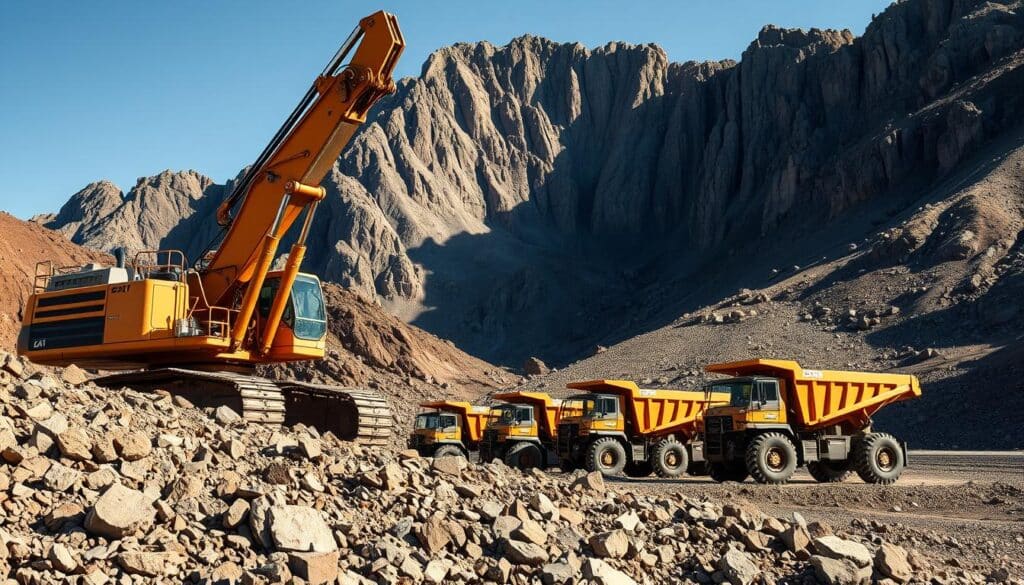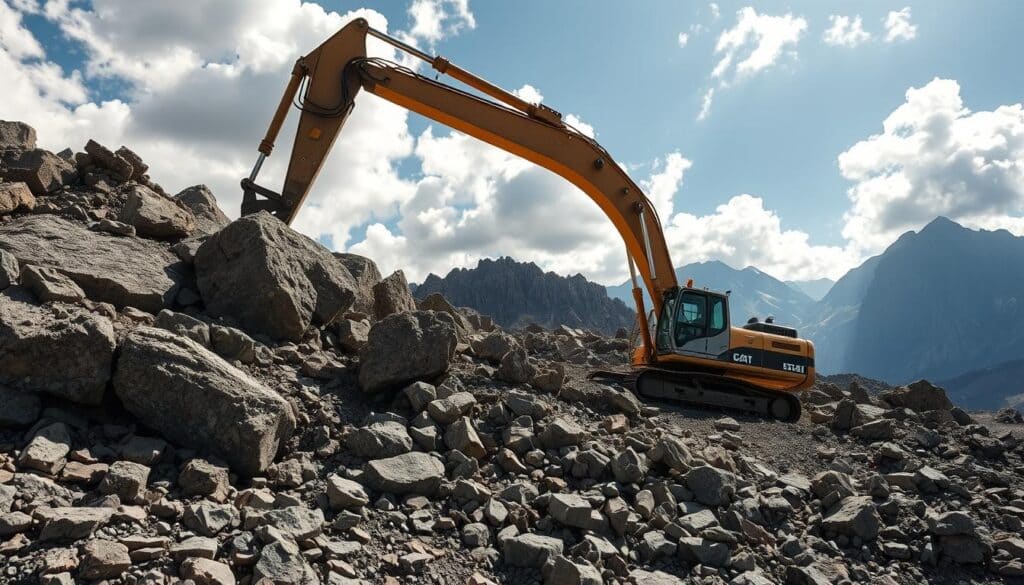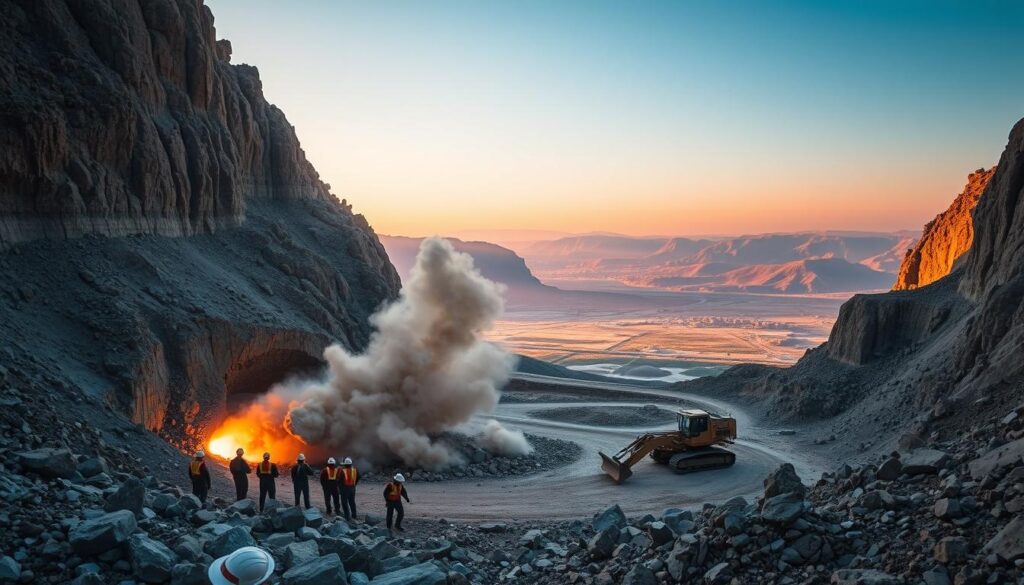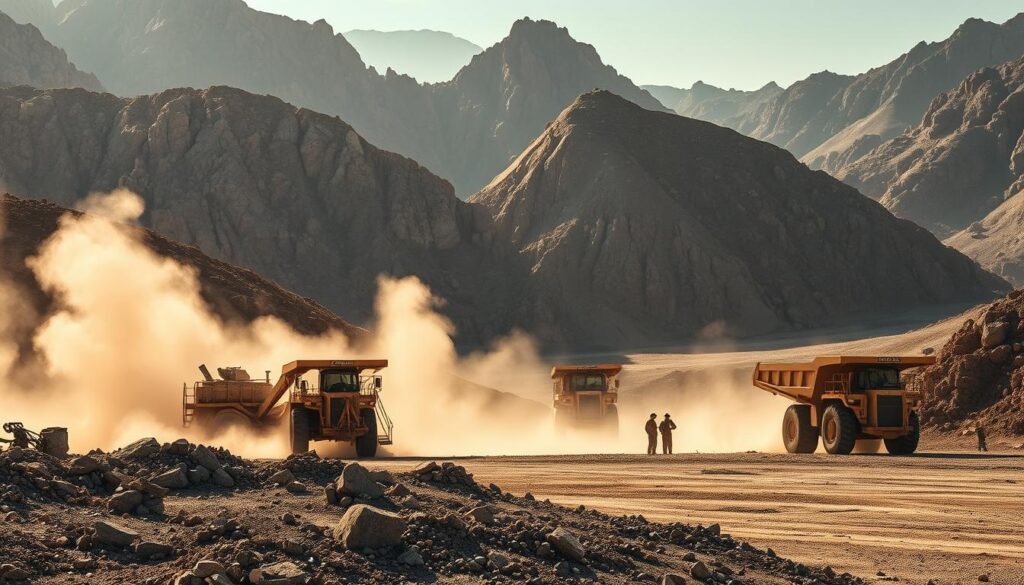Rock excavation is a big challenge in construction projects across Canada. PAR’s Services Ltd is an expert in dealing with rocky terrain. They provide solutions for breaking through tough ground conditions.
Breaking through solid rock needs special techniques and advanced tools. Construction workers must know how to manage rocky terrain. This includes assessing the site and removing materials.
To do excavation well, you need to know about/”>about the ground, choose the right tools, and use new rock breaking methods. PAR’s Services Ltd has a lot of experience. They handle tough excavation projects in British Columbia and more.
Key Takeaways
- Specialized tools are essential for rock excavation
- Proper site assessment determines excavation strategy
- Multiple rock breaking techniques exist for different terrain
- Safety and precision are critical in rocky terrain excavation
- Advanced equipment enhances excavation efficiency
- Environmental considerations play a critical role in excavation planning
Understanding Rocky Terrain Characteristics
Excavation projects face unique challenges with different rock formations. The techniques for breaking and drilling rocks change based on the terrain’s geology. Knowing these details is key for planning successful excavations.

Rock formations fall into three main types, each with its own set of challenges for drilling and blasting:
- Sedimentary Rocks: These are softer and layered
- Limestone
- Sandstone
- Easier to excavate
- Metamorphic Rocks: These are dense and hard
- Marble
- Slate
- More challenging to break
- Igneous Rocks: The hardest and most resistant
- Granite
- Basalt
- Requires specialized rock breaking techniques
Geological Assessment Methods
Professional geological surveys are vital for planning excavations. Geotechnical experts use advanced methods to study rock composition. They then decide the best drilling and blasting strategies.
Soil Composition Analysis
Soil testing gives important insights into ground conditions. Factors like moisture, rock density, and structural integrity affect excavation complexity. They also influence the choice of equipment for rock breaking.
Accurate geological assessment can reduce unforeseen complications by up to 40% during excavation projects in rocky terrain.
Essential Equipment for Rock Excavation

Mechanical excavation in rocky terrain needs special equipment. This equipment is made to handle tough geological conditions. Contractors use strong machines to break through rocks safely and efficiently.
The heart of rock excavation includes several key heavy machines:
- Excavators with rock-specific attachments
- Hydraulic rock breakers
- Rockwheels and rockcrushers
- Terrain leveling machines
The Vermeer T1255 Terrain Leveler SEM is a top example. It can cut up to 12 feet wide and 32 inches deep in one pass. It’s powered by CAT engines with 350 to 600 horsepower.
Key features of excavation equipment include:
- Precise rock fragmentation
- Minimal environmental disturbance
- High-efficiency material removal
- Adaptability to varying rock densities
Today’s mechanical excavation equipment brings big benefits. It means no need for many machines and lower costs. It also allows for precise rock removal, making projects more efficient.
Mechanical Excavation Techniques
Rock excavation needs advanced methods to handle tough terrain. Mechanical excavation is key for breaking through hard rock efficiently and accurately.

The difficulty of removing rock changes based on the terrain. Various mechanical methods help contractors face different rock challenges:
- Hydraulic hammering for dense rock surfaces
- Drum cutting for precise removal
- Ripping techniques for breaking compacted materials
Hydraulic Breaking Methods
Hydraulic hammering is great for breaking through hard rock. These tools use high-energy impacts to efficiently cut through rock with little environmental harm.
Drum Cutting Technology
Drum cutting is a top-notch method for rock excavation. It uses rotating drums with carbide-tipped teeth for precise rock removal, perfect for trenches and tunnels.
Ripping and Scarifying Approaches
Ripping uses special equipment to tear through hard rock. Contractors use powerful attachments to fracture and loosen dense rock.
| Excavation Method | Rock Density Suitability | Precision Level |
|---|---|---|
| Hydraulic Hammering | High-density rocks | Medium |
| Drum Cutting | Moderate-density rocks | High |
| Ripping | Varied rock compositions | Low to Medium |
Choosing the right equipment for rock excavation is critical. Knowing each method’s strengths helps achieve the best results for a project.
Excavation in Rocky Terrain Methods
Excavating in rocky terrain is tough and needs special techniques. Choosing the right method is key for a project’s success, safety, and cost. It’s all about doing it right in rocky areas.

There are many ways to excavate in rocky terrain, each with its own benefits. The main methods are:
- Mechanical excavation using hydraulic hammers
- Controlled blasting techniques
- Ripping and scarifying methods
- Diamond wire sawing
- Rock drilling
Mechanical methods work well for harder rocks. Hydraulic hammers offer precise control, perfect for areas where you don’t want to disturb much. For softer rocks like limestone, ripping can speed up the work by 20%.
| Excavation Method | Best Suited For | Efficiency Increase |
|---|---|---|
| Hydraulic Hammers | Urban Projects | 15% |
| Controlled Blasting | Large-Scale Projects | 25% |
| Ripping | Sedimentary Rocks | 20% |
Controlled blasting is best for big projects like building roads and mines. It’s great for removing lots of rock when machines can’t handle it. Safety and careful planning are very important for this method.
Excavation costs can go up by 30% because of wear and tear on equipment and more labor. Experts need to look at the site, the rock, and the project details to pick the best method.
Blasting Operations and Safety Protocols
Rock blasting is key in excavation, facing tough geology. It needs careful planning and safety rules for success and safety.

Good safety steps are vital for rock blasting. Here are the main points for safe blasting:
- Setting up safe zones
- Using clear communication
- Doing detailed checks before blasting
- Managing people carefully
Explosive Material Handling
Handling explosives in controlled blasting is very precise. Important parts include:
- Measuring explosives accurately
- Safe transport methods
- Right storage conditions
- Qualified people watching over
Controlled Blasting Techniques
Modern blasting methods reduce harm to the environment and boost digging efficiency. Key methods are:
| Technique | Primary Benefit |
|---|---|
| Pre-Splitting | Less rock breaks off |
| Smooth Blasting | Creates clean walls |
| Cushion Blasting | Less shakes the ground |
Safety Measures and Regulations
Following strict rules is essential in blasting. Important safety steps are:
- A 200-meter safe area
- A Blaster-in-Charge to watch over
- Being ready for emergencies
- Keeping detailed records after blasting
Safety in rock blasting is not an option—it’s a must.
Surface Mining Technologies

Surface mining technologies are key for digging in rocky areas, mainly in open-pit mines. They help mines get minerals from the surface. This makes mining more efficient.
Surface miners have changed how we dig rocks. They use special tools for tough terrains. In Canada, these tools are vital for mining, even in hard-to-reach areas.
“Surface mining methods account for more than two-thirds of the world’s yearly mineral production” – Mining Industry Research
Surface mining has big benefits:
- It digs faster than old methods
- It costs less to run
- It’s good for shallow deposits
- It’s more precise in removing rocks
When using surface miners, knowing the geology is essential. Things like rock type, depth, and mineral amount guide the digging plan. In Alberta, for example, only a small part of the oil sands are close enough to mine.
Today’s surface mining uses cutting and extraction techniques that are better for the environment. These methods help mines deal with rocky areas better. They cut down on waste and improve how minerals are taken out.
Advanced Drilling Techniques
Drilling is key in understanding and managing rock formations during excavation projects. Modern drilling techniques offer precise methods for rock breaking and geological assessment. This makes excavation efficient and safe.

Rock excavation experts use various drilling methods to evaluate and prepare terrain. These advanced techniques help find the best approach for rock breaking and site preparation.
Rotary Drilling Methods
Rotary drilling involves rotating drill bits to penetrate and analyze rock formations. It has several key advantages:
- Precise rock sampling
- Minimal ground disturbance
- Ability to assess geological structures
- Adaptable to different rock compositions
Percussion Drilling Systems
Percussion drilling uses impact force to break through hard rock surfaces. It’s effective for:
- Breaking compact rock layers
- Creating boreholes for further investigation
- Preparing sites for possible blasting
Core Drilling Applications
Core drilling extracts cylindrical rock samples, giving detailed insights into subsurface conditions. It’s vital for:
- Geological research
- Mineral exploration
- Foundation assessment
| Drilling Technique | Primary Use | Rock Compatibility |
|---|---|---|
| Rotary Drilling | Geological Sampling | Sedimentary, Igneous |
| Percussion Drilling | Rock Breaking | Hard, Compact Rocks |
| Core Drilling | Detailed Analysis | All Rock Types |
Choosing the right drilling technique depends on the project’s needs, rock type, and excavation goals.
Site Preparation and Planning

Starting a rocky terrain excavation project needs careful site preparation and planning. The first steps are critical to avoid problems and work efficiently.
Important steps for site preparation include:
- Conducting thorough geotechnical site investigations
- Identifying underground structures
- Analyzing geological formations
- Assessing slope stability and terrain characteristics
Geotechnical surveys are key to understanding the ground. Experts usually spend 1-2 months on detailed reports. These reports give vital insights into site challenges.
| Preparation Stage | Duration | Key Activities |
|---|---|---|
| Initial Survey | 2-3 weeks | Ground mapping and hazard identification |
| Geological Assessment | 3-4 weeks | Rock formation analysis and soil composition study |
| Site Access Planning | 1-2 weeks | Equipment logistics and terrain accessibility |
Modern tech can boost excavation accuracy by 20%. This means fewer mistakes and better project flow. Advanced tools and survey methods help create strong plans for rocky terrain.
Safety is always top priority during site prep. Good risk management can cut up to 70% of site hazards. Safety systems and careful planning keep workers safe and the project on track.
Environmental Impact Considerations
Rock excavation projects need careful planning to protect the environment. Contractors must find a balance between doing the job well and being kind to nature. This is true when using methods like mechanical excavation and controlled blasting.

The impact of excavation on the environment can be big. It’s important to have a plan to keep ecosystems and communities safe.
Erosion Control Methods
Stopping soil loss and keeping water clean is key. Here are some ways to do it:
- Implementing protective ground covers
- Creating sediment barriers
- Establishing drainage management systems
- Utilizing geotextile materials for stabilization
Dust Management Strategies
Keeping the air clean during excavation is vital. Here are some ways to do it:
- Regular site water spraying
- Covering stockpiled materials
- Installing temporary wind barriers
- Using dust suppression equipment
“Minimizing environmental impact requires proactive and innovative management techniques.” – Environmental Engineering Journal
Noise Reduction Techniques
Reducing noise from blasting and excavation is important. Here are some ways to do it:
- Sound-absorbing barriers
- Scheduling work during permitted hours
- Using modern, quieter equipment
- Implementing acoustic monitoring
Being mindful of the environment in rock excavation helps protect nature. It also makes sure projects can be done in a way that lasts.
Cost Analysis and Project Management

Excavation in rocky terrain needs careful financial planning and smart project management. The challenge of rock excavation calls for a detailed cost estimate and resource planning.
Important cost factors for rock excavation include:
- Equipment rental expenses
- Labor costs
- Material procurement
- Site preparation
- Specialized geological assessment
Excavation costs can vary a lot, from $50 to $200 per cubic yard. Small projects might cost between $400 and $1,500. But, big rock removal can cost over $20,000. Renting a full-sized excavator is 50% more than a smaller backhoe.
Effective project management for rocky terrain excavation involves:
- Detailed site surveying
- Comprehensive soil sampling
- Advanced preparation techniques
- Risk mitigation planning
Labor rates for residential excavation are usually $120 to $150 per hour. Experienced contractors might charge more but can save time and money.
Accurate cost estimation is the cornerstone of successful rock excavation projects.
Other things to consider are seasonal changes, equipment costs, and possible extra expenses. Using parametric estimation and detailed cost breakdowns helps predict costs better. This prevents going over budget.
Specialized Equipment Maintenance

Keeping specialized rock excavation equipment in top shape is key for its performance and life. Good maintenance boosts efficiency, safety, and saves costs on projects.
Preventive Maintenance Schedules
Creating a solid preventive maintenance plan is vital for hydraulic hammering tools and other rock excavation gear. It’s wise to have a detailed maintenance schedule that includes:
- Daily visual checks of equipment
- Weekly lubrication and wear checks
- Monthly system diagnostics
- Quarterly detailed component checks
Equipment Troubleshooting Guide
Knowing how to fix common problems with mechanical excavation equipment is important. Key areas to focus on include:
- Monitoring hydraulic system pressure
- Checking wear patterns
- Assessing vibration and noise
- Testing electrical system performance
Performance Optimization Tips
Improving rock excavation equipment performance is possible with the right maintenance. The Xcentric Ripper Mining Series, for example, can reach production rates of up to 450 m³/h with proper care.
Regular maintenance is not an expense, but an investment in equipment longevity and project success.
By sticking to strict maintenance routines, contractors can cut downtime, extend equipment life, and boost hydraulic hammering performance in tough excavation settings.
Safety Protocols and Risk Management

Safety is the key in rock blasting and controlled blasting. Excavation projects need strict safety rules to keep workers and equipment safe.
OSHA excavation standards in Title 29 Part 1926 give detailed safety guidelines. The main dangers in rock excavation are:
- Ground collapse risk
- Dangers of handling explosives
- Risks from operating equipment
- Atmospheric contamination
Managing risks in controlled blasting needs a careful safety plan. Important safety steps include:
- Daily site inspections are a must
- Workers need thorough training
- Wearing the right protective gear is key
- Always look out for hazards
Rock blasting needs special safety steps. Experts must check the site, design safety systems, and watch closely. Workers must learn about explosives, using equipment, and how to act in emergencies.
Important safety rules for rock excavation include wearing bright vests, checking the air, and having clear communication. Regular talks about safe access, traffic rules, and ground movement risks help keep the work area safe.
Weather Considerations and Seasonal Planning
Excavation in rocky terrain needs careful planning for weather challenges. Successful projects need strategies for seasonal changes and environmental factors.

Weather affects rock excavation in many ways, changing project needs all year. It’s key for keeping work running smoothly and keeping workers safe.
Winter Excavation Techniques
Winter brings special challenges for rocky terrain excavation. Frozen ground needs special methods:
- Use heated equipment to avoid breakdowns
- Apply thermal blankets for thawing
- Choose hydraulic fluids that work in cold
- Use special winter machines for digging
“Proper winter preparation can reduce project delays by up to 40%.” – Canadian Excavation Association
Wet Weather Operations
Dealing with water is key for rock excavation projects. High water tables can really slow things down:
- Set up advanced dewatering systems
- Use water-resistant hydraulic excavators
- Install French drains to keep water away
- Check water levels often
Temperature Impact Management
Temperature changes need flexible excavation plans. In British Columbia, the ground changes a lot depending on the area:
- Coastal areas: Ground thaws quickly
- Mountain regions: Ground changes slowly
- Northern territories: Ground stays frozen longer
Planning for different seasons is important. The best time for excavation is usually from April to October, with the summer being the most efficient.
With advanced weather monitoring and flexible techniques, teams can safely and precisely work in tough terrain and weather.
Legal Requirements and Permits

Understanding the legal side is key for rock blasting and excavation. Contractors need to know the rules to follow the law and avoid fines.
Important legal points for rock excavation include:
- Getting all necessary project permits
- Doing detailed environmental impact studies
- Following local, provincial, and federal laws
- Keeping workers safe and trained
Any project over $50,000 needs a Notice of Project. For deep trenches, strict safety rules and records are required.
Essential legal steps for excavation are:
- Finding and marking underground services
- Doing daily site checks by experts
- Providing the right safety gear and training
- Keeping up with health and safety policies
Workers can say no to unsafe tasks to protect themselves. Following Ontario Regulation 406/19 is a must, mainly for big soil removal projects.
Safety and legal rules are not optional—they are essential for successful excavation projects.
Project Documentation and Reporting
Effective documentation is key in excavation in rocky terrain methods. It ensures transparency, safety, and legal compliance. This is vital in complex rock excavation operations.
Key documentation requirements for rock excavation projects include:
- Detailed site surveys and geological assessments
- Comprehensive safety reports
- Progress tracking documentation
- Risk management records
- Equipment maintenance logs
Project documentation has many important roles. Proper reporting helps project managers track progress, communicate with stakeholders, and maintain a record of site activities.
Legal regulations require specific documentation practices. In Canada, project documentation must include:
- Notice of project submitted at least 24 hours before work begins
- Starting date and estimated project duration
- Site safety documentation
- Geotechnical investigation reports
Critical documentation elements must be kept for at least 10 years. Employers should keep detailed records of site activities, safety protocols, and risk assessments. This ensures compliance and protects worker safety during rock excavation projects.
Accurate documentation is not just a regulatory requirement—it’s a fundamental aspect of successful project management in rock excavation.
Conclusion
Rock excavation is a complex task that needs careful planning, special tools, and expert skills. It involves understanding rock breaking, precise drilling, and advanced blasting. These steps are key to safely and efficiently removing earth from rocky areas.
Teams working on rock excavation use advanced tech like GPS-guided machines and 3D laser scanning. They also use tools for detailed geological assessments. This helps them handle the tough challenges of rocky terrain safely and efficiently.
If you need rock excavation in British Columbia, call PAR’s Services Ltd at +(604) 278-4445. Our team is experienced in using the latest drilling and blasting methods. We tailor our services to fit your project’s specific needs, ensuring safety and quality.
Success in rock excavation comes from choosing the right methods and understanding the terrain. It also means putting safety first and protecting the environment. By using new technologies and following strict standards, projects can overcome rocky terrain hurdles.
